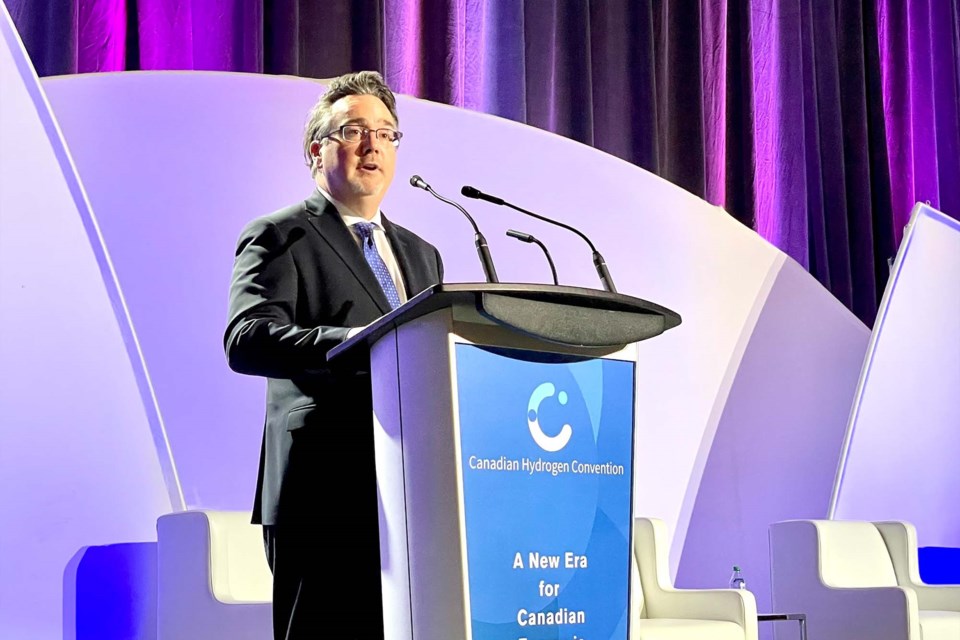Great West Media has received federal government funding through the Local Journalism Initiative to support a reporter to cover climate in Alberta.
Jen Henderson will feature in-depth reporting on where Alberta is at with actions to reduce carbon emissions and generation of less carbon-intensive energy, along with climate issues across the province as they intersect with industry, business, the environment, the economy, communities, and lifestyles.
If you have a story idea, please email [email protected].
Alberta will soon have a new facility to help speed up advancements and technology in the hydrogen sector, Alberta Premier Jason Kenney announced this week.
On Tuesday, Kenney said the province will provide $50 million in funding for the Clean Hydrogen Centre of Excellence, a place Alberta’s Minister of Natural Gas and Electricity Dale Nally said he hopes will accelerate the industry in Alberta.
Some $10 million will go to capital costs, to fund things such as testing new technology, Nally said in an interview with Great West Media, while the remaining $40 million will be operational. The centre will be run by Alberta Innovates — the province's largest research and innovation agency.
Nally hopes the funding announcement will attract another $50 million to $100 million toward the initiative from other levels of government and industry partners.
“We're expecting this $50 million to become a much bigger number, which means more projects that can be supported,” Nally said.
The minister said Alberta has been working on producing hydrogen for 10 years, and the province wants to continue to be an industry leader. The new hydrogen centre will be part of a hub-and-spoke model, Nally said, with the new centre as the hub, and spokes reaching out to academia and industry.
“It will be co-ordinating a lot of different things with the goal of getting projects that are early on in development, through proof of concept and beyond, to completion,” Nally said.
The centre won’t necessarily focus on projects which are already well underway, Nally said, but rather it will support companies trying out new tech.
“We've been meeting with other companies that are playing around in the hydrogen space with some cool technologies and they just they just need that help to get them over the finish line,” Nally said.
Help might come in the form of having a place to test the technology; access to industry experts or academics; or grants to further projects.
The premier's announcement came during the first Canadian Hydrogen Convention, held in Edmonton from April 26-28, and made it clear the province will be banking on the hydrogen industry.
“The hydrogen sector is moving so fast, it’s almost hard to believe where we’ve come in just the last couple of years,” Kenney said on Tuesday afternoon to a convention attended by 2,000 people.
“We have everything that is needed to become a major producer of clean, reliable, and affordable hydrogen energy.”
Last fall the province released the hydrogen road map, outlining Alberta’s plan to lead the industry globally. It is expected the hydrogen industry could be worth $2.5 trillion globally by 2050.
Across Canada, it is estimated that hydrogen could be worth $100 billion annually.
Hydrogen can be used to contribute to the clean-energy transition, with opportunity for the product to be used to power large trucks, for power generation, heating, and other industrial uses.
The conference drew in big announcements. On day one, Calgary-based TC Energy announced it would be working with Nikola Corp., a company manufacturing trucks, on a proposed hydrogen production hub in Crossfield, Alta.
The hub would be set up to produce and distribute hydrogen to big, long-haul trucks, along with support hydrogen distribution for power and heat.
One of the industry's current challenges is distribution, Nally said in an interview with Great West Media, and while there is some current infrastructure in the province to move the product, there must be a lot more.
While Alberta does have pipelines to distribute products through the province and to the coast, pure hydrogen can’t be transported through them, and needs to be diluted with methane or ammonia or it will break the pipelines.
“Utilizing ammonia methanol as a carrier of hydrogen allows us to get into the export game within the next couple of years," Nally said.
New pipelines for pure hydrogen would need to be built to move the produce efficiently through the province if it will be used to fuel vehicles, said the minister.
These hydrogen vehicles will compete with electric vehicles, but new infrastructure to move hydrogen through the province will be built by industry and won’t cost taxpayer dollars, said Nally. If the province immediately switched to all electric vehicles, there wouldn’t be enough power on the electricity grid to support them.
“Hydrogen vehicles are scalable. Electric vehicles are not. The reason electric vehicles are not scalable is because we don't have the electricity infrastructure to support them,” Nally said.
The federal government set aside $600 million in its recent budget to improve the electricity grid across Canada. “That’s a drop in the bucket,” said Nally, adding that money could build one new transmission line in the province.
In the future, there will probably be multiple types of vehicles on the road, including hydrogen, electric and combustion engines, said Nally. “I think it'll be a mix, but I know one thing for sure is it will not be all [electric vehicles]. It just can't be.”



